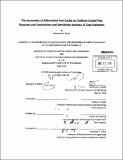The economics of alternative fuel cycles on sodium-cooled fast reactors and uncertainty and sensitivity analysis of cost estimates
Author(s)
Russo, Genevieve V. (Genevieve Virgina)
DownloadFull printable version (5.233Mb)
Other Contributors
Massachusetts Institute of Technology. Dept. of Nuclear Science and Engineering.
Advisor
Andrew C. Kadak.
Terms of use
Metadata
Show full item recordAbstract
Previous work was done to create a baseline capital cost model for the SFR in which case studies were performed to identify ways to decrease the capital costs while maintaining safety and performance. This thesis expands on the capital cost model to include uncertainty analysis, as well as performing qualitative cost evaluations for the fuel cycle and O&M costs. An uncertainty model was developed from the available data for capital account costs, the point estimate and the contingency. After evaluating several alternative uncertainty models, a reasonable model was created by assuming the capital account costs to be lognormal distributions and assigning the point estimate as the 10th percentile and the contingency amount as the standard deviation for each of the accounts. The resulting Total Capital Cost distribution fits the mental model of cost estimating practices for Engineering, Procurement and Constructor (EPC) contractors. The Total Cost Distribution determined in this thesis has the best estimate without contingency below the 10th percentile, the best estimate plus contingency near the 50 th percentile, and the 90 th percentile equal to 110% of the best estimate plus contingency. Statistical analysis was performed on the SFR capital cost distribution and an assumed LWR capital cost distribution. The purpose of this exercise was to determine the statistical significance of the difference between the expected LWR and SFR capital costs for given mean costs and standard deviations. The result is that the estimated cost of the SFR is greater than the expected LWR cost and the difference is statistically significant. While the capital cost distributions for the two reactors overlap, the methodology provides a way to quantify the differences. While fuel cycle costs for the reprocessing alternatives, aqueous and pyroprocessing, are largely unknown, a comparison was made between the two based on several factors that could influence the cost: capital costs, waste streams, proliferation concerns, and technology readiness to inform the fuel choices for SFRs - namely oxide or metallic from a fuel cycle perspective. As a result, the aqueous process is thought to be more economical based on proven technology, reduced and lower cost waste streams, and the process costs of reprocessing and fuel fabrication. Other factors, such as the symbiotic relationship between LWRs and SFRs and the location of the facility, could have significant effects on the fuel cycle cost component of the total cost of electricity for an SFR. Centralized facilities have economic advantages in fuel cycle cost savings and depending on how spent fuel from light water reactors is treated - namely as a cost to the utility for removal, it could be a fuel cycle savings for SFRs. Based on SFR operating experience, there have been several O&M issues unique to the SFR design which have the potential to increase O&M costs. Past operating experience is not encouraging but if the lessons learned are applied in design, such as ease of inspection, monitoring, and ease of replacement of known troublesome equipment, the expectation is that there should be no inherent O&M cost differentials between LWRs and SFRs if best practices are followed. The choice of fuel type for SFRs, namely metal or oxide, is left to other operating plant capital cost decisions based on risk informed safety analyses.
Description
Thesis (S.M. and S.B.)--Massachusetts Institute of Technology, Dept. of Nuclear Science and Engineering, 2010. Cataloged from PDF version of thesis. Includes bibliographical references (p. 78-79).
Date issued
2010Department
Massachusetts Institute of Technology. Department of Nuclear Science and EngineeringPublisher
Massachusetts Institute of Technology
Keywords
Nuclear Science and Engineering.